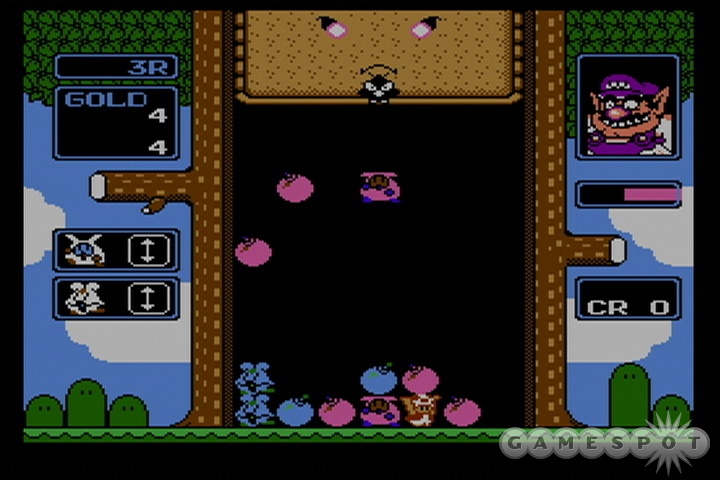Can you name the last licensed game for the Nintendo Entertainment System? That's right, it's Wario's Woods, a quirky, cute puzzler that was released for the NES in 1994. Because it was released so late in the system's life, many people missed out on this fun puzzle game. So it's fitting that it's one of the first titles available on the Virtual Console. It's hard not to be disappointed that Nintendo chose to release the NES version of the game rather than the superior Super NES version, but this incarnation is still an addictive and surprisingly complex game.

There isn't really a story behind Wario's Woods. While Wario is in the game, the diminutive Toad is actually the star of the show. The game begins with Toad at the bottom of the screen while different-colored bombs and creatures falling from the sky. You control Toad, picking up and moving objects in an effort to line up at least two creatures and one bomb of the same color either vertically, horizontally, or diagonally to get them to disappear (some creatures can only be erased in one particular orientation). A thorough tutorial guides you through the basics of picking up and moving objects and even kicking them as you endeavor to get three in a row. As objects pile up, you'll need to climb them, snag specific objects from the middle, and quickly move them around before the screen (which gets smaller thanks to a ceiling that Wario slowly lowers) fills with objects. There's a time meter that determines whether bombs or creatures will fall from the sky and when the ceiling will lower. When all the bombs and creatures that were onscreen are cleared, you collect coins and move on to the next level.
This sounds easy at first, but there's a surprising amount of depth to the gameplay. The game gets challenging as you try to clear the screen of objects while contending with the ceiling being lowered, creatures that can be erased only when stacked in specific directions, and the game switching from dropping enemies to dropping bombs every so often. But the difficulty ramps up slowly, so even if you're not all that good, you can play for a long time before feeling overwhelmed.
There are several different ways to enjoy Wario's Woods. Round game has an A mode, which you simply play until the screen fills; it also has a B mode, which has a boss battle every 10 rounds. Time race has you beating levels as fast as possible and tracks your best times as you go. The two-player versus mode pits you and a friend against one another to see who can clear a stage the fastest. The first person to win three rounds wins the match. Because the game originally had a battery save system, you don't have to worry about using a save state to keep your high scores intact, which is nice.
Thanks in no small part to the fact that it was released in 1994, Wario's Woods looks pretty nice for an NES game. There are lots of bright colors and quite a lot going on onscreen at once. The little creatures dance around; Birdo and Wario, who are in the corner, are animated; there's a fairy flying around the top of the screen; and there are lots of explosions too. There's occasionally a bit of slowdown, but it generally occurs only when everything blows up as you clear a stage. Unfortunately, the game doesn't sound quite as good as it looks. The music's catchy but repetitive, and the sound effects are rather poor.
The only problem with Wario's Woods is that it's the NES game and not the superior SNES version, which had a CPU versus mode, better graphics, and more abilities for Toad. Even though this might not be the ideal version, puzzle game fans will find that it's still a lot of fun and there's plenty of replay value to be had, thanks to the many different game modes.